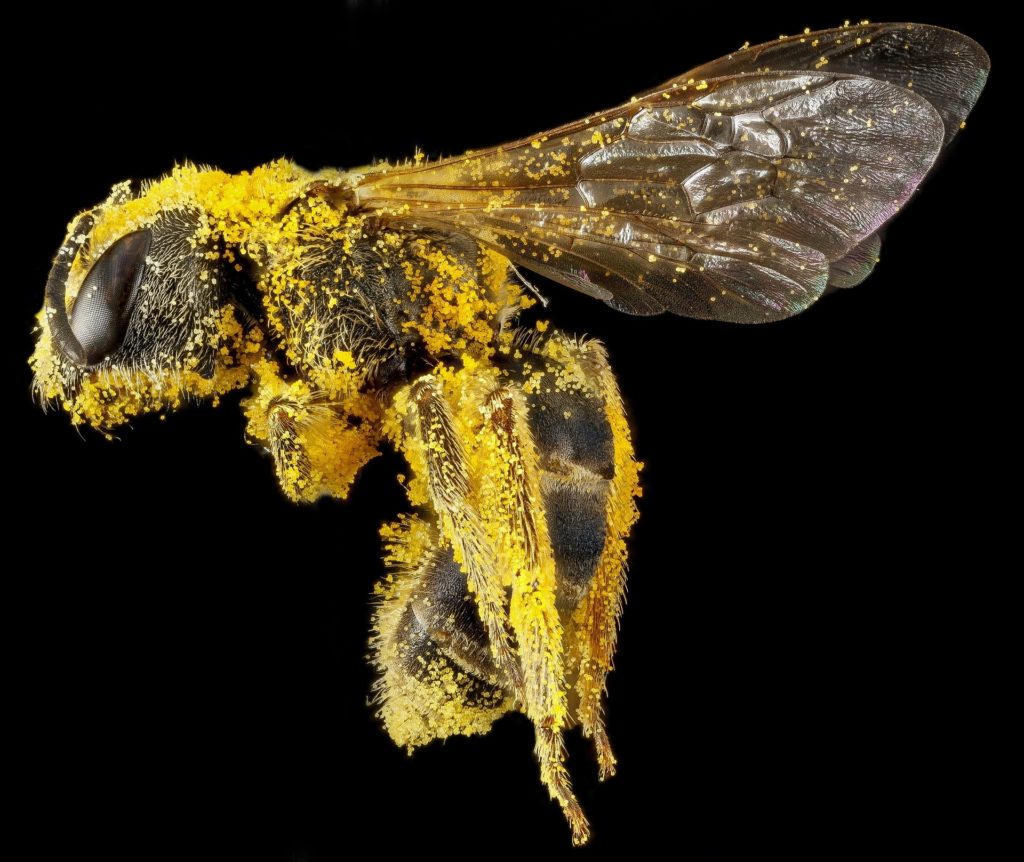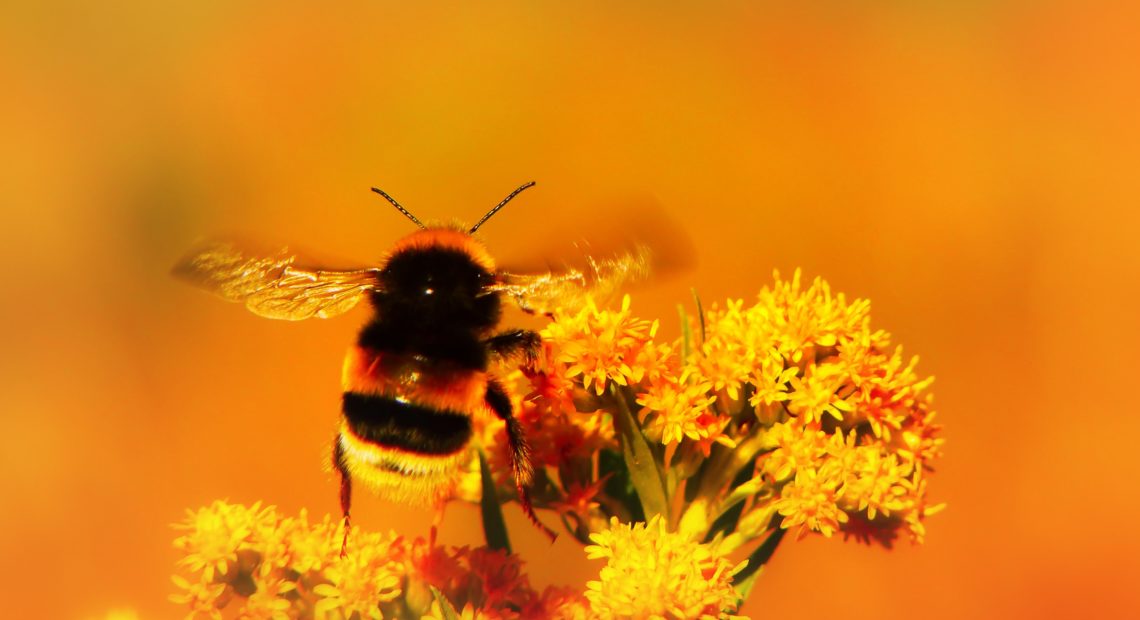The annual Biodiversity and Councils’ All-Ireland Pollinator conference put the spotlight on local authorities’ vital role in protecting threatened pollinators.
One-third of Ireland’s bee species now face extinction. Habitat loss, pesticide use, and dwindling biodiversity are decimating our 20 native species of bumblebee and 77 species of wild solitary bee. Councils can lead the battle to save pollinators. That was the message at Cork’s recent Biodiversity and Councils’ All-Ireland Pollinator Plan conference, as originally reported by Ellie Byrne in the Irish Examiner.
While gardeners, farmers, businesses, and community groups play a role in reversing the fate of Ireland’s bee species, local authorities, who manage large tracts of public land, must change their land management practices to help the insects on which we rely for our food crops.
Representatives from city and county councils nationwide attended the day-long conference of talks on strategies to help declining bee species. Topics included cultivating wildflower meadows, reducing the use of pesticides, and planting pollinator-friendly flowers in public parks.
Dr Úna Fitzpatrick is a senior ecologist at the National Biodiversity Data Centre and one of the forces behind the All-Ireland Pollinator Plan, 2015-2020.
As the country-wide action plan reaches the end of its five-year term, Dr Fitzpatrick said things are still “pretty dire” for Ireland’s 97 bee species. “Between 2012 and 2018, species were still in decline,” she said.
However, it could be 2025 or even 2030 before the All-Ireland Pollinator Plan has an impact and before threatened pollinators show signs of a recovery, Dr Fitzgerald said.
Many Irish people feel local and national government isn’t putting pollinators first.
Some 88% of Irish people said the Government isn’t working hard enough to save bees, according to a survey conducted by the All-Ireland Pollinator plan last year. And 72% want more educational measures, 69% want government bodies to stop using pesticides, and 63% want more pollinator-friendly planting in parks.
On the All-Ireland Pollinator Plan’s interactive map, even school children are out-performing local authorities: Irish councils have recorded 80 actions to protect bees since the All-Ireland Pollinator Plan was launched in 2015. But schools have recorded 91.
Community groups, including Tidy Towns committees, have recorded 312 actions and there have been 218 actions from gardens.
Now, just one year from the end of the five-year plan, local authorities are signing up to a framework agreement, launched in March 2019, in a bid by the All-Ireland Pollinator Plan to improve uptake from councils. Dr Fitzpatrick said the response from councils has been “really positive”.
The agreement calls on local authorities to take one pollinator-promoting action within the first year, to make a record of the actions they are taking, and to provide an annual report.
Of Ireland’s 31 local authorities, six have so far signed up.
‘This is a long game, but one we’re happy to commit to’
In early March 4th, Cathaoirleach of Kilkenny County Council, Cllr. Eamon Aylward and Chief Executive Colette Byrne signed a framework agreement with the All-Ireland Pollinator Plan to formalise Kilkenny County Council’s long-term commitment to support pollinators in County Kilkenny, becoming the first county to do so.
The All-Ireland Pollinator Plan is a cross-sector initiative, led by the National Biodiversity Data Centre, with local authorities, farmers, businesses, schools and local communities to support pollinators such as bees. Ireland depends on pollinating insects to pollinate crops, fruits and vegetables. Unfortunately, many of our pollinators are now threatened with extinction.
Cllr. Eamon Aylward said “We are delighted to be the first Local Authority in the country to sign up to the Pollinator Plan. Last summer the Council adopted the garden bumblebee as our emblem, so this agreement is an obvious next step for us. There’s much better awareness now about the plight of the bees, and the fact that all of us, including County Councils, can do something to help them.”
The strength of the Pollinator Plan is its evidence-based guidelines which give clear advice on how each sector can improve their land for pollinators – for instance, by reducing grass mowing; by allowing hedgerows to bloom; by planting pollinator-friendly plants; or by reducing the use of pesticides. By helping our pollinators, the Pollinator Plan also improves the landscape for biodiversity generally across the island.
According to Kilkenny Chief Executive Colette Byrne “There isn’t an instant solution to the decline of the bees, but as a Local Authority we can play a small but important role in helping them. We’ll start by looking at the services we provide, such as public parks, road maintenance, and community grants and supports, to see what actions we can take which will help pollinators. This is a long game, but one we’re happy to commit to.”
Many Local Authorities have been taking actions to support pollinators on public land over the past number of years. Many are also working with local community groups, residents’ associations and schools to help raise awareness of the All-Ireland Pollinator Plan. To better support these efforts and to better promote the work being undertaken, this new partnership framework aims to formally recognise Councils as partners of the All-Ireland Pollinator Plan and to give them recognition for their work.
Speaking about this new partnership with Kilkenny County Council, Dr Úna FitzPatrick, All-Ireland Pollinator Plan founder and Project Coordinator, said “This is such an exciting step. We have witnessed so much positive action by individuals and local communities around the country, and so many councils have made changes to the way they manage their parks and public lands – to make them more pollinator-friendly. We are thrilled that Kilkenny have become the first Council partner to the plan. Kilkenny has really supported the plan from the very beginning, and the Kilkenny Heritage Office has created some really impressive awareness campaigns, particularly to communicate the plan in local schools and Tidy Towns groups.”
In becoming an All-Ireland Pollinator Plan Partner, Local Authorities agree to support the ethos of the All-Ireland Pollinator Plan; to consider the Plan in their policies, plans, and management decisions where possible; to carry out one pollinator-friendly action in the first year of signing up and plan to carry out at least three more within the following five years. Local authority partners will also provide updates on the pollinator actions they have planned, implemented or maintained at the end of each year. With current challenges to the natural world, including Climate Change, the All-Ireland Pollinator Plan offers local authorities a way of conserving the free ecosystem services provided by pollinating insects.

Stark warnings
Dun Laoghaire Rathdown Co Council (DLRCC) has radically overhauled its land management, in response to the pollinator crisis; in 2018, they eliminated chemical use on public lands, apart from invasive species control, and now use hot-water machines for weed control.
They have also changed their verge-cutting and management of public land. This is to allow to flower plants that are needed as a food source by bees.
But DLRCC biodiversity manager, Anne Murray, said the public need to be educated and that she has received complaints that the council is not doing its job.
Weeding out out-dated mentalities is an important aspect of the pollinator plan, Ms Murray, and several other speakers, emphasised: instead of seeing flowering plants, like dandelions, as weeds to be eradicated, the public must see these plants as a vital seasonal food source for bees.
Ms Murray has heard complaints from elderly residents who perceive long grass as untidy: one complainant said they thought that the long grass would encourage drug dealers into the area. “People think we’re not managing sites, because they think we’re trying to save money or reduce our workload,” she said.
In fact, it’s more expensive to manage public land for pollinators: Ms Murray said regular maintenance costs €84 per hectare annually, but up to €140 per hectare when land is managed for pollinators, mostly caused by composting costs.
Trinity College botanist, Dr Jane Stout, has a stark warning for councils about use of pesticides, including neonicotinoids, a group of systemic insecticides that are known bee-killers, and glyphosate, the herbicide shown last year to damage bees’ health and navigation abilities.
Farmers may get a bad rap for their use of pesticides, but traditionally managed lawns and green spaces can bear up to 10 times the pesticide burden of agricultural land, according to US biodiversity group The Audubon Society.
Dr Stout said that while the use of pesticides on agricultural land is measured, we have no way of knowing the quantity of pesticides used on local authority lands, and that the full impact of pesticides on pollinators, which are a “flagship for biodiversity”, is not yet fully understood.
Some 77% of Irish honey samples were found to contain traces of pesticides in a recent study, Dr Stout said, proving that insecticides, herbicides, and fungicides are contaminating pollinators’ food chain.
“Outside of agricultural settings, we don’t know how much is being used,” she said.
“It seems prudent, given that we don’t know the impacts of these pesticides, to seek alternatives and to change perception.”
Reduce, rethink, and replace pesticides with something less-damaging, Dr Stout says.













